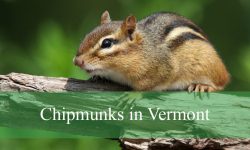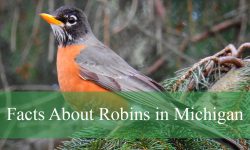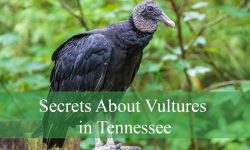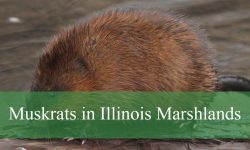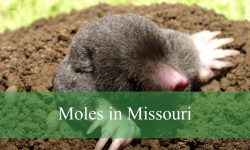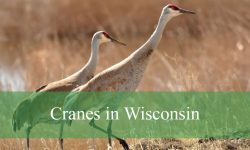California hosts a rich diversity of deer species, each adapted to the state’s wide-ranging environments. From coastal forests to desert valleys, the types of deer in California reflect the incredible variety of landscapes they inhabit. These deer can be identified by differences in size, coloration, tail patterns, and behavior.
Learning about the main types of deer in California provides valuable insight into their habitats and lifestyles. Some prefer the shaded redwoods of the north, while others thrive in arid desert regions or chaparral-covered hills. Recognizing their unique traits helps deepen your connection with California’s native wildlife.
This guide explores five distinct types of deer in California, complete with pictures and identification details. It offers a closer look at how each subspecies lives, what it eats, and where it can most often be seen throughout the Golden State.
Common Types of Deer Found in California
Columbian Black-tailed Deer (Odocoileus hemionus columbianus)
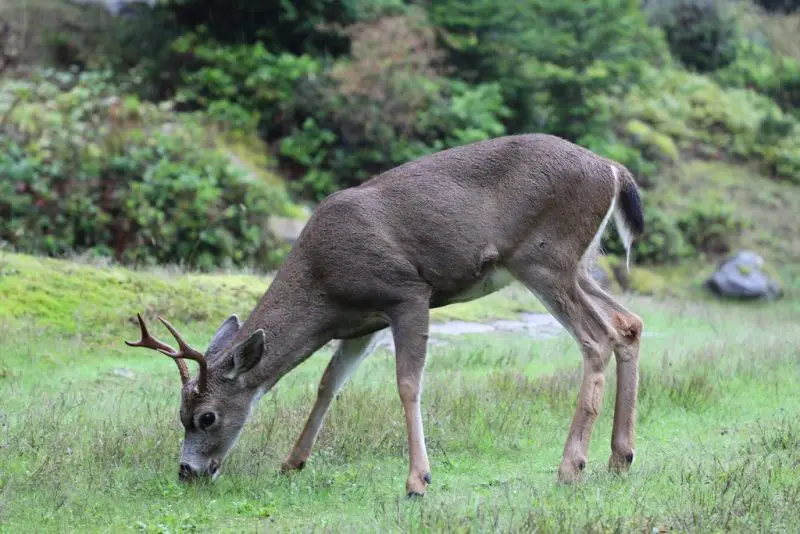
The Columbian Black-tailed Deer is a coastal subspecies of mule deer commonly found in the northern and central coastal ranges of California. This deer is known for its characteristic black tail, which contrasts with its light brown to grayish coat. Adult bucks often have a stocky build with a short neck and a set of forked antlers that are less massive than those of inland mule deer. Does are smaller and lack antlers entirely.
This subspecies tends to prefer dense forested habitats, particularly old-growth forests dominated by Douglas fir, redwoods, and coastal pines. They are crepuscular, meaning they are most active at dawn and dusk. Their movement is typically more restricted compared to migratory inland species, with home ranges often centered around a reliable water source.
Columbian Black-tailed Deer feed on a wide variety of plants including forbs, shrubs, and grasses, but especially favor blackberry, huckleberry, and salal in coastal understories. Their diet can shift seasonally depending on vegetation availability, and they are efficient browsers. Fawns are typically born in late spring and early summer, with twins being common.
In California, their range extends from the Oregon border south through Humboldt, Mendocino, and Sonoma counties, and as far south as the Santa Cruz Mountains. They are a favored game species in the region and play an important ecological role as prey for mountain lions and black bears.
California Mule Deer (Odocoileus hemionus californicus)
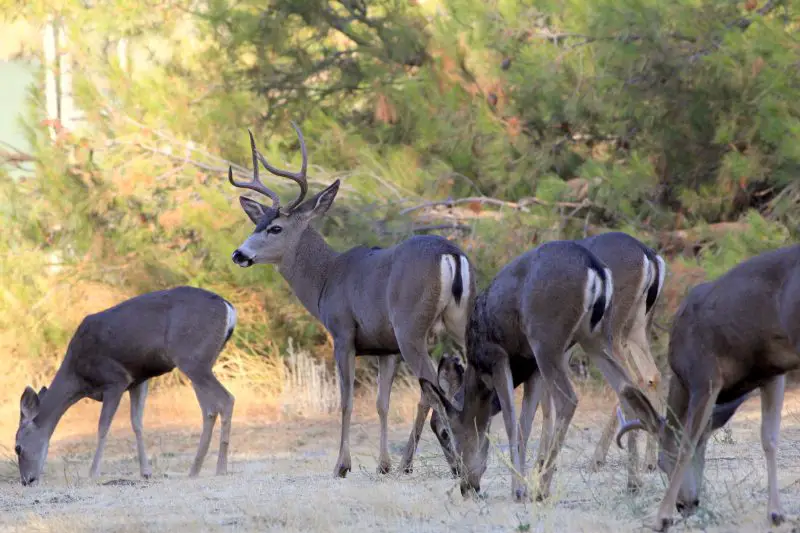
The California Mule Deer is one of the most widespread and recognizable deer in the state, known for its large ears, which resemble those of a mule. Its coat ranges from tawny brown in summer to grayish-brown in winter, and the tail is white with a black tip, distinguishing it from the Columbian Black-tailed Deer. Adult males, or bucks, can weigh up to 200 pounds, while females, or does, typically weigh less.
This subspecies occupies a broad range of habitats including oak woodlands, mixed conifer forests, foothill chaparral, and even suburban edges. They are partially migratory, often moving to higher elevations in summer and descending to lower elevations during the winter. Their movements are guided by seasonal changes in food availability and snow cover.
Their diet is varied and includes twigs, leaves, acorns, and herbaceous plants. In drier seasons, they may forage on chaparral plants like chamise and manzanita. Bucks typically shed their antlers in late winter and begin growing new ones in spring, which are fully formed by the fall rut.
In California, California Mule Deer are commonly found from the Sierra Nevada foothills to the Central Coast and even into the Central Valley edges. They are frequently observed in areas such as Yosemite, the Santa Lucia Range, and the Diablo Range. Their adaptability has made them a prominent figure in both wild and developed landscapes.
Inyo Mule Deer (Odocoileus hemionus inyoensis)
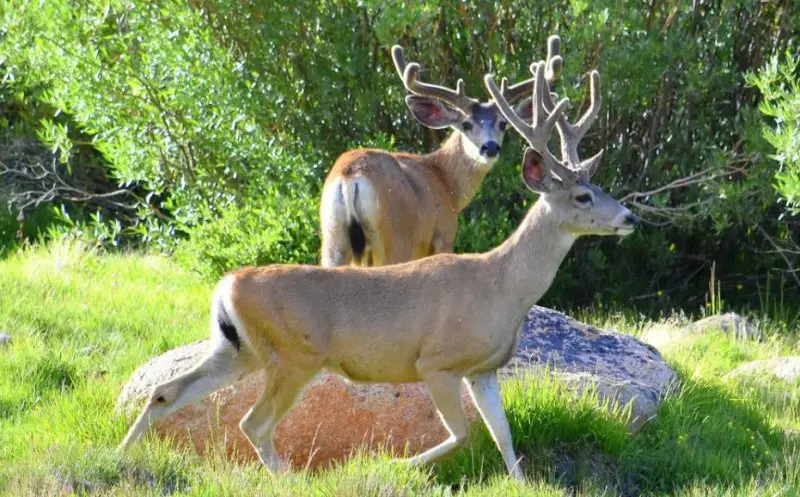
The Inyo Mule Deer is a desert-adapted subspecies found along the eastern side of California’s Sierra Nevada, especially in Inyo and Mono counties. They are medium to large-sized deer with long legs, large ears, and a light brown to grayish coat that helps them blend into rocky, arid environments. Their tail is similar in appearance to that of other mule deer, with a white base and black tip.
Unlike some coastal species, the Inyo Mule Deer exhibits strong seasonal migration patterns, often traveling between high-elevation summer ranges and low-elevation wintering grounds. These migrations can span over 50 miles and are influenced by snow cover and forage availability. They are more mobile than black-tailed deer due to their open and often rugged habitats.
Their diet consists of bitterbrush, sagebrush, buckwheat, and other drought-tolerant shrubs. During the spring and summer, they may also consume grasses and wildflowers in alpine meadows. These deer are well adapted to harsh climates with minimal water and can survive on moisture from their food during dry periods.
The Inyo Mule Deer is found primarily in eastern California, particularly in the White Mountains, Owens Valley, and around Bishop. They are less commonly seen by casual observers due to their remote habitat but are a key species for mountain predators and an important part of the high desert ecosystem.
Desert Mule Deer (Odocoileus hemionus eremicus)
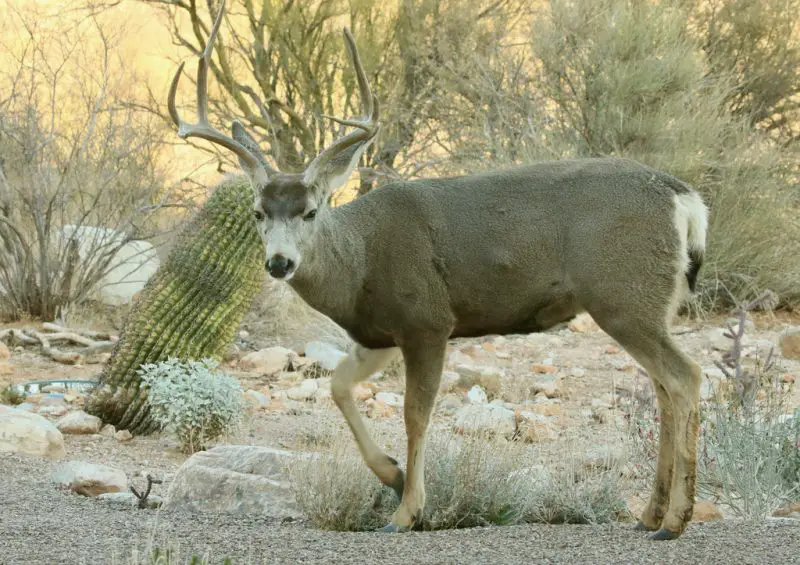
Desert Mule Deer inhabit the hot, dry regions of southeastern California, including the Mojave and Colorado Deserts. These deer are well adapted to arid conditions, with a thinner body frame and lighter coat that reflects sunlight. Their large ears help with thermoregulation, and their coat changes slightly between seasons for better camouflage.
This subspecies avoids the intense daytime heat by becoming crepuscular or nocturnal, especially during summer months. They tend to stick close to desert washes, rocky hillsides, and areas with mesquite, creosote bush, and ocotillo, which provide both cover and forage. Water sources are critical, and they are often seen near springs or man-made guzzlers.
Their diet includes cactus pads, mesquite leaves, desert grasses, and other xeric plants. They can extract moisture from food and go long periods without drinking water directly. During wetter seasons, they browse more broadly on green shrubs and flowering annuals. Fawns are usually born in early summer when food is relatively more available.
In California, the Desert Mule Deer’s range includes Riverside, San Bernardino, and Imperial counties, particularly near Joshua Tree National Park and Anza-Borrego Desert State Park. Their population is more scattered and faces threats from drought and habitat loss, but they remain an important part of desert biodiversity.
Southern Mule Deer (Odocoileus hemionus fuliginatus)
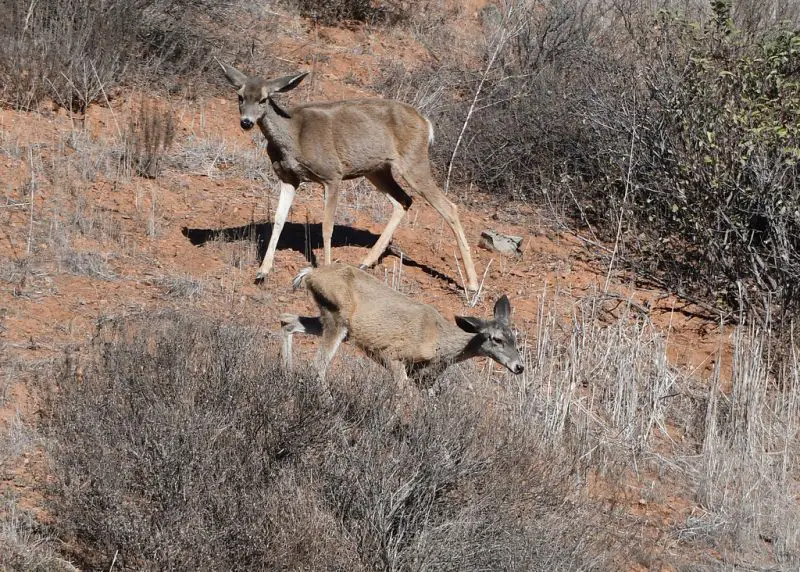
The Southern Mule Deer is found in southwestern California, especially in San Diego, Orange, and parts of Riverside and Los Angeles counties. They are smaller and darker in coloration than their northern counterparts, with shorter snouts and darker faces. Their tails are similar in pattern to other mule deer, with a white underside and black tip.
This subspecies favors Mediterranean-type habitats, such as coastal sage scrub, chaparral, and oak woodland. They are well adapted to fragmented habitats and can often be seen near suburban developments and protected open spaces. Their movements are usually limited compared to migratory deer, but they do adjust seasonally to elevation and water availability.
Southern Mule Deer browse on a variety of native plants including buckwheat, ceanothus, sage, and even ornamental vegetation in suburban gardens. During dry periods, they may also consume cactus and drought-tolerant shrubs. Their diet and behavior make them highly adaptable, though they are vulnerable to vehicle collisions and habitat fragmentation.
In California, they are commonly found in areas like the Santa Ana Mountains, Cuyamaca Mountains, and the coastal foothills near San Diego. Because of their proximity to urban zones, they are often the most frequently encountered deer in southern parts of the state. They serve as an important ecological bridge between wildlands and human-altered landscapes.
Comparison Table of Deer Types in California
Deer Type |
Scientific Name |
Size |
Color & Tail |
Habitat |
Behavior |
Distribution in California |
|---|---|---|---|---|---|---|
Columbian Black-tailed Deer |
O. h. columbianus |
Medium |
Brown-gray coat; tail is dark brown to black-tipped |
Coastal forests, redwoods, dense brushlands |
Non-migratory; crepuscular |
Northern & Central Coast (e.g., Humboldt, Sonoma) |
California Mule Deer |
O. h. californicus |
Medium to Large |
Tan to grayish coat; black-tipped white tail |
Oak woodland, chaparral, Sierra foothills |
Partially migratory; active at dawn/dusk |
Sierra Nevada, Central Coast, Central Valley edges |
Inyo Mule Deer |
O. h. inyoensis |
Medium to Large |
Light brown/gray; white rump with black-tipped tail |
Arid mountains, high desert, alpine meadows |
Long-distance migratory; follows seasonal forage |
Eastern Sierra, Inyo & Mono counties |
Desert Mule Deer |
O. h. eremicus |
Medium |
Pale tan coat; large ears; tail like other mule deer |
Mojave & Colorado Deserts; rocky washes |
Mostly nocturnal; heat-adapted |
Southeastern CA (e.g., Joshua Tree, Anza-Borrego) |
Southern Mule Deer |
O. h. fuliginatus |
Small to Medium |
Darker coat; shorter snout; black-tipped white tail |
Coastal sage scrub, oak woodlands, chaparral |
Sedentary; adapts to suburban edge habitats |
Southern CA (e.g., San Diego, Orange, Santa Ana Mountains) |
FAQs about Types of Deer in California
What are the main types of deer found in California?
California is home to five main types of deer, all of which are subspecies of mule deer. These include the Columbian Black-tailed Deer, California Mule Deer, Inyo Mule Deer, Desert Mule Deer, and Southern Mule Deer. Each type is adapted to specific habitats and regions across the state.
How can you tell the difference between deer types in California?
The easiest way to distinguish between deer types is by examining their size, tail color, coat, and habitat. For example, Columbian Black-tailed Deer have a distinctive dark tail and prefer forested coastal areas, while Desert Mule Deer have lighter coats and live in arid deserts.
Which type of deer is most common in California?
The California Mule Deer is the most widespread and commonly encountered species in the state. It inhabits a variety of landscapes from the Sierra Nevada foothills to coastal mountains and even urban edges.
Are California deer migratory?
Some deer species in California, like the California Mule Deer and Inyo Mule Deer, exhibit seasonal migration between elevations. Others, such as the Columbian Black-tailed Deer and Southern Mule Deer, are more sedentary and stay within a limited home range.
Where can I see deer in California?
Deer can be spotted throughout the state depending on the species. Yosemite National Park, the Santa Lucia Mountains, Redwood forests, Anza-Borrego Desert, and the Santa Ana Mountains are all good places to observe different types of deer.
Do all California deer have antlers?
Only male deer, known as bucks, grow antlers. These antlers are shed each winter and regrown during the spring and summer. The size and shape of antlers can vary between subspecies and are used for dominance displays and fighting during the rut.
What do California deer eat?
Deer in California are herbivores and consume a wide variety of vegetation. Their diet typically includes grasses, shrubs, leaves, twigs, acorns, wildflowers, and in arid regions, even cactus and desert plants. Diet varies by region and season.
Are there any threats to deer populations in California?
Yes, deer face threats such as habitat loss, drought, vehicle collisions, disease, and predation. Urban sprawl particularly affects Southern Mule Deer, while drought and wildfires are major concerns for Desert and Inyo Mule Deer.
Are California deer protected by law?
Deer in California are managed by the California Department of Fish and Wildlife. While hunting is permitted in designated seasons with proper tags and regulations, all species are protected from illegal hunting and harassment.
Can California deer interbreed between subspecies?
Yes, interbreeding between mule deer subspecies can occur where their ranges overlap. This sometimes makes subspecies identification more difficult and can lead to hybrid traits, especially in transitional zones.

